I appreciate the opportunity to share a few thoughts and experiences here as a guest blogger on Photoshop Insider. I’ve been blogging regularly for over six years over on my blog Photo Business News. Aside from the various photo business related news, one of the common themes I blog about is the business side of photography.
Why?
Simply put, if you love photography – and want to earn a living at it – if you don’t include in your daily routine an attention to the business-side, you won’t be earning a living at it for very long. If your dream is to one day change careers to become a professional photographer and earn a living at it – then attending to the (sometimes) hum-drum nature of estimates, invoices, bills, and receipts is critical, alongside with the matter of pricing your work to survive and thrive. In the early years I stumbled along the way. I’d like to save you some of those lumps and struggles.
DETERMINING A CLIENT’S BUDGET
Often one of the hardest things to do is to have a client tell you what their budget is. Now, there are many occasions where they will – the key is to ask! Sometimes, a client will tell you they don’t know, but more often than not when they say that, they do.
There is a point in the conversation where you have had a good dialog with the client and you feel like you’ve made a connection with them. At this point, as you’re letting them know you’ll send along your paperwork, I typically will ask:
“Did you have a budget you are trying to work within for this?”
Can you guess the operative word in that sentence? Usually when I ask that question during a presentation people say “budget” or “within,” but as the process of elimination works it’s way through the sentence, someone says “trying.” If someone asks for a portrait to be shot, and they say $100, there’s no way we’ll be able to work within that. $2,500? Yes. $1,500, maybe, it depends.
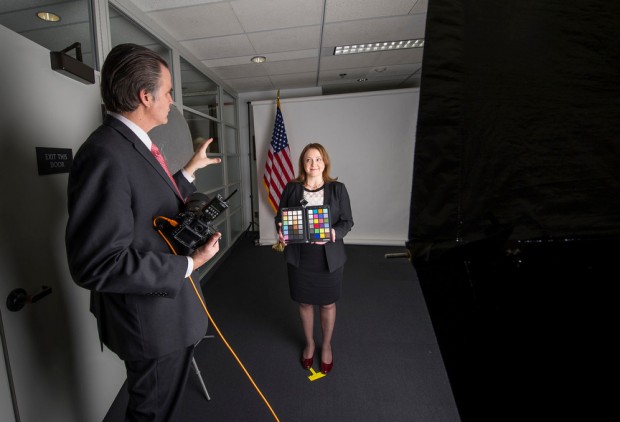
Photographing Register of Copyrights Maria Pallante for her official portrait. Photo ©Lindsay King
Consider that you’re a really good architectural photographer. There are many levels of photography within this realm. There’s the “realtor with a camera” that snaps a shot of the front of a house at high noon when the light is at it’s worst. Then at the other end there’s the high end commercial real estate photographer who will do a site visit to scout the location, identify the best time of day to take the photo for the front elevation and an alternative outside view. They will work with the building manager to ensure all the blinds in the windows are at just the right height, and that all the lights are turned on. They will get permits to clear the street in front of the building of cars, and if it’s a winter shoot with deciduous trees in front of the building, they will ensure that the finished image has a tree with leaves on it through the magic of Photoshop.
When you run into a client who says they don’t have a budget, this is when you can start asking questions:
YOU: “I’m trying to understand the level of production to bring into play for this shoot. Were you trying to keep this to under $5,000?”
CLIENT: “Oh my. I didn’t think it would cost that much. I figured it would be about $500.”
So here we have a huge disconnect. If this client came to you, the really good architectural photographer, because there were amazing shots of all sorts of buildings and high-end home exteriors, shot with just the right balance of dusk daylight and warm glowing windows, clearly you’re not the $500 level of photographer.
YOU: “You’ve had a chance to look over my website, and for what you’ve budgeted, I can stop by the next time I’m in that neighborhood and shoot a shot. Did you want me to worry about if the sun is on the front of the building, or did you just need a snapshot?”
CLIENT: “Oh, I really want the sun on the front of the building.”
YOU: “Ok, well, in order to know that, I’ll need to do a site visit. That takes extra time and effort.”
CLIENT: “Ok, well I might be able to afford $1,000.”
YOU: “I understand that you came into this project with a few ideas as to what it would cost to do the photograph. You’ve seen my work, and those images have been used to encourage builders to build, buyers to buy, and renters to rent, all sooner rather than later. One extra month’s rent from one tenant is a significant amount of money, and this shoot, even at $5,000 is a small fraction of that.”
CLIENT: “I just don’t understand why it costs so much.”
YOU: “There are a number of factors. The first is time, but not just in the ‘by the hour’ type of thing. Not only do we need to do a site visit, but we need to coordinate with the building manager (or current tenant if it’s already occupied and/or a home). We then need to schedule our time to be there not just for the exteriors, but the interiors you want as well. We will then get a permit to block off the street so people can see the entire building and we don’t risk a large truck being parked outside all day. I’ll have an assistant working with me to get everything looking just right as well. Then, once we’re done with all the photography, we spend a fair amount of time on each image back in the studio making it look its best, adjusting color and light. We’ll also remove the parking meters and street signs that are visual distractions. We’ll add in green leaves to the tree as if it were Spring since this picture is being taken in the Fall after all the leaves are gone. If everything goes well, it’ll take a day. If not, it’ll take two. Then if we have weather delays when it’s overcast or rainy, we have to reschedule.”
And the explanation can go on and on. There are a myriad of variables here. Maybe you don’t need to pull a permit. Maybe it’s Spring already. In the above example, a $5,000 budget would be great for a large commercial building in a business district. It would take us time to do all of the things necessary. If we had to cut costs perhaps we’d shoot fewer interiors, or one exterior view. Maybe a permit isn’t needed, and maybe maybe maybe.
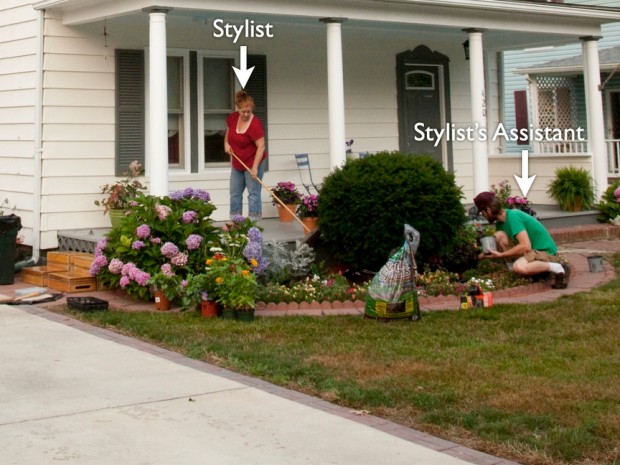
No, that's not a family member of mine and my second cousin. That's two hired stylists staging and styling a home for a photo shoot. Photo © John Harrington
Some portraits call for a level of production that includes wardrobe, separate hair and makeup stylists, and so on. Some on-location photo shoots call for a production trailer (usually a customized motor-home that goes for about $800 a day including driver) so models can change in the back while the client has a place to work and review images in the front. Catering comes into play when there are a number of players on the shoot and we are shooting across a mealtime – who wants everyone scattering to find the nearest Subway or Quiznos? At some point your shoot will call for a producer who will make all these arrangements for you, for a fee of about $750 a day.

A separate talent trailer and one for the client means that honest and candid conversations about the talent can be had discretely, and the client doesn't have to hear if the talent is displeased with something. Photo © John Harrington
Asking “what budget are you trying to work within?” isn’t a trick question – an honest answer from the prospective client gives you an understanding as to the level of production they expect. If it’s a portrait shoot where the client only has $750, then it’s a pretty lean shoot with a small seamless, a few small soft-boxes and one final image as a deliverable and a limited rights package. If the client wants to be able to review the images on-site and see some basic or conceptual retouching, then having a digital tech using our digital workstation with a 30″ external monitor along with a Wacom tablet adds in anywhere between $750 and $1500 to the shoot production. Adding in a makeup person for the day adds in $500, a separate stylist doubles that. Separate hair? Yep, another $500. So a lean shoot at $750 adds in $750 for a digital tech to $1,500, and then separate hair and makeup brings it to a $2,500 portrait. Yes, your take-home remains $750 plus whatever markup you have, but the production level more than tripled the bill.
ESTABLISHING CONFIDENCE TO WIN THE ASSIGNMENT
There are countless things that take place before a shoot is brought to you via a phone call or email. More often than not, the intermediaries in the PR department of an organization have been tasked with finding a photographer for a project. Perhaps there’s an ad agency and a publicist for the VIP talent, and so on. The more intermediaries, the more pressure for it to work perfectly. Even on the smallest of CEO shoots, their PR person is on the hook for you doing a good job and not making them look bad. So, if they call you and say:
“Hi, this is Jane Doe with ACME Widgets, and we need a portrait of our CEO with the production line in the background. Are you available next Wednesday?”
Saying anything other than something like this doesn’t instill confidence:
“Sure we can do that. We do executive portraiture all the time. In fact, we just wrapped up a series of executive portraits last week. Wednesday works well for us too, but we’ll need to check in with the regular makeup person we use for portraits of this caliber, unless your CEO has someone they prefer to use whenever they do media appearances?”
This sentence said smoothly and with a confident tone, demonstrates a level of professionalism and attention to detail that will set you aside from others. Then there are a myriad of questions to ask next that will further demonstrate your experience here:
“Does the CEO have a vision for the shoot? By that I mean – is s/he trying to demonstrate they are a hands-on CEO that is connected to the production line staff, or an authoritative CEO in full command and control? A few ways to illustrate these two styles would be without a suit jacket with sleeves rolled up, or with a buttoned up dark suit and crisp white shirt shot from a low angle to demonstrate power and authority.”
“Do we need to ensure that the production line is running next Wednesday at the time s/he’s available, or is it a 24/7 operation?”
“Is the CEO approaching this with enthusiasm or are they reluctant to do the portrait? Knowing this helps us understand how to approach them on the day of the shoot to get the most out of them.”
In one instance, we were called on to do a portrait of a duo in three separate locations, within 45 minutes. What seemed as a logistical nightmare actually was an opportunity for us to sell the client on our problem-solving abilities. We demonstrated how we would pre-set all the lights with a producer for each location. Our budget was north of $10,000, but we were the only photographer who demonstrated we could do it within their timeframe. Afterwards when we asked how they came to select us, that's how we learned that not only were we the most expensive, but also, the only one they were confident could accomplish the shoot within the available window of time.
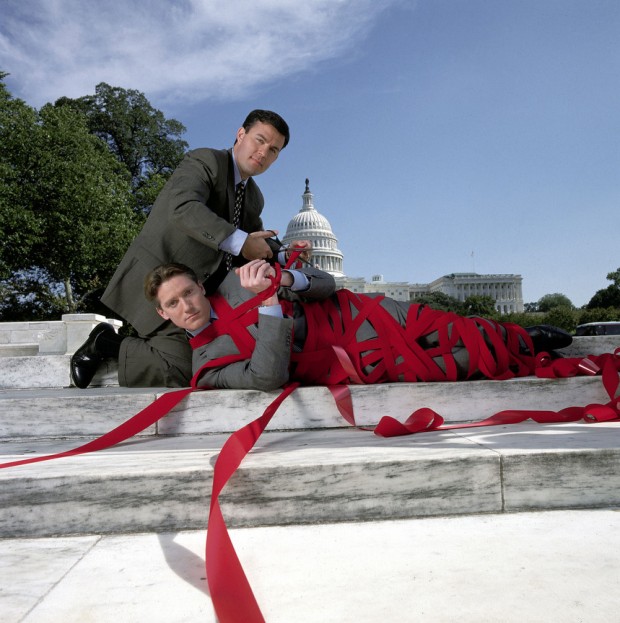
One of the three setups for this duo we photographed. Photo © John Harrington
Realizing that you have to exude comfortable and cool confidence during the initial phase of the conversation, as well as enthusiasm for the shoot will start you off on the right foot. Your job is, yes, to make great images, but also, to make the person who hired you look great too. In doing so, not only will they be happy with the results, but they will be sure to book you in the future.
Last week we got a call on Tuesday for a shoot on Wednesday. The company – which I won’t name but you’d know their name instantly – was coming to Washington DC for a last minute photo shoot. It was a big deal for them – as their top communications person who handles all of it and reports directly to the President and CEO, was flying in. We had two hours to do two shoots. No lights, one assistant. No permits, no time. During the course of the back-and-forth we talked through our creative ideas and our solutions for the shoot, as well as the workarounds to the permitting issue. We had a signed contract by 5pm, and re-adjusted our schedule for an early morning start. At 7:30pm in DC, an email came in (they’re on West Coast time so it's still working hours for them) saying the client needed near real-time images to put out on social media. We responded by 8pm telling them “no problem” and added in our digital workstation to the mix to handle that. After the shoot, we sent an invite to the image gallery on PhotoShelter, and got back a really wonderful email:
John-
I don't even know where to begin thanking you.
Everything could not have gone more smoothly for us because of you.
Our clients were THRILLED to have you along for the ride, and super impressed with your experience and credentials in D.C.
You made everything super seamless, and I can't thank you enough for your flexibility and go-with-the-flow attitude.
So glad we found you⦠thank you {referring colleague who was CC’d} !
All the best-
This is exactly the type of client we not only strive to have, but also, strive to deliver for. This is a client who recognizes the value of a premium service, and for whom price is not a deciding factor, but instead, only a detail. They CC’d their colleague within the firm who recommended me, which makes him look good and so he’ll be sure to refer me again. The firm, in turn, looked great to this company who was doing a very high profile project that the CEO wanted executed, so the in-house guy who reports to the CEO gets kudos from his boss too.
Warren Buffett said it best: "Price is what you pay. Value is what you get." He also said "Your premium brand had better be delivering something special, or it’s not going to get the business."
If you’d like to hear more from John, check out this interview he recently did with The Photo Brigade!
Washington DC Photographer John Harrington has covered the world of politics, traveled internationally, working as an editorial and commercial photographer. He has completed assignments for or his work has appeared in The Washington Post, USA Today, Time, Life, Newsweek, The National Geographic Society, and Rolling Stone. Author of Best Business Practices for Photographers, John has lectured across the country to every major trade association. He currently serves as a National Director on the board of the American Society of Media Photographers, and concluded serving his second term as the President of the White House News Photographers Association in May of 2011. A 2007 recipient of the United Nations’ Leadership Award in the field of photography, he also received the NPPA’s Morris Berman Citation in 2007 for special contributions advancing the interests of photojournalism, and in 2013 he was awarded the J. Winton Lemen Fellowship Award for continuing outstanding service in the interests of press photography and for outstanding technical achievement in photography.



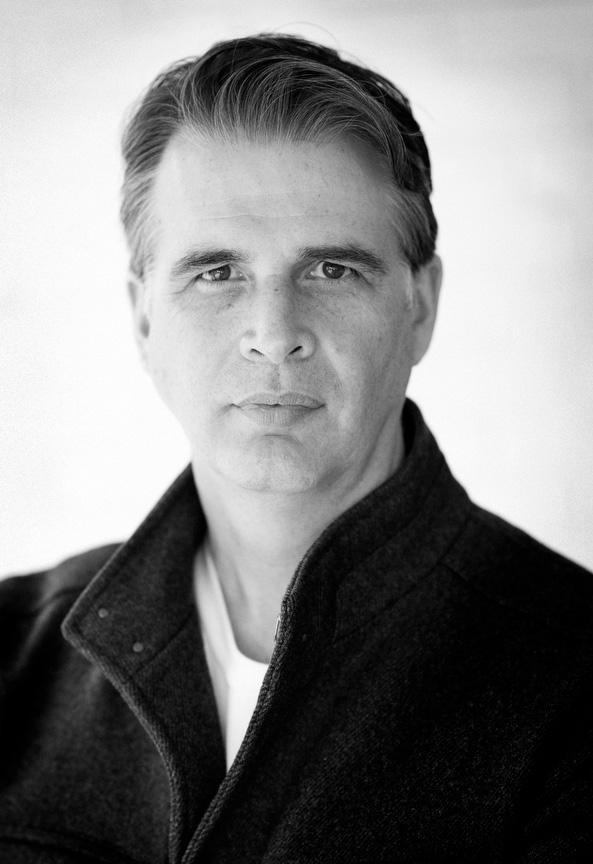
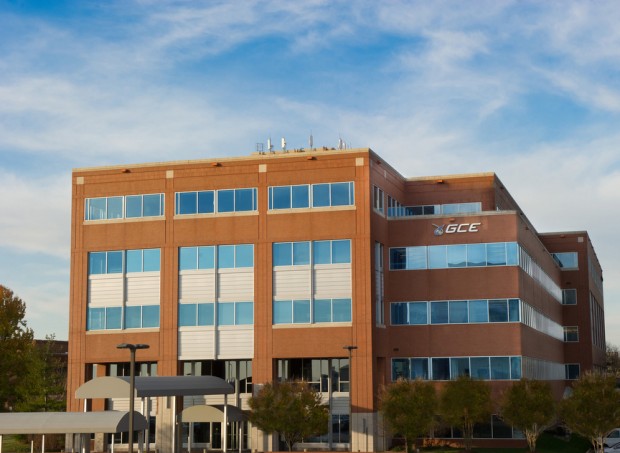
Holy cow this helps me. Photography is my life long passion but not my sustaining income. I have been shooting commercial property for several years for some high dollar clients and paid well. I recently did a business for a relative, quick shot for $200 only to find out at a sister site they paid another photog $1500. I will be more vigilant from now on!
This will take me some time to digest. Makes perfect sense though. And I think you just gained a regular reader of your blog.
Thanks so much for this John. Wow!
Very incetful and informative. A great article.